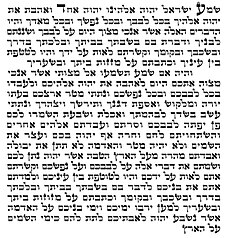 The parchment of the mezuzah | |
| Halakhic texts relating to this article | |
|---|---|
| Torah: | Deuteronomy 6:9 and Deuteronomy 11:21 |
| Mishnah: | Menachot 3:7 |
| Babylonian Talmud: | Shabbat 32a, Yoma 11a, Menachot 33a, |
| Mishneh Torah: | Tefillin, Mezuzah, veSefer Torah ch 5-6 |
| Shulchan Aruch: | Yoreh De'ah 285-291 |
בָּרוּךְ אַתָּה יי אֱלֹהֵינוּ מֶלֶךְ הָעוֹלָם, אֲשֶׁר קִדְּשַׁנוּ בְּמִצְוֹתָיו וְצִוָנוּ לִקְבּוֹעַ מְזוּזָה
sources for research edit
http://www.israelnationalnews.com/News/AllFlashes.aspx
http://www.stabroeknews.com/guyana-review/poem/
1. Shmuel Katz, Days of Fire (NY 1968), 252-82 2. ibid. 281-2 3. ibid. 260-80 4. ibid. 261-2 5. Shmuel Katz, Lone Wolf, a Biography of Zev Jabotinsky (NY 1996), 272, 302 passim regarding the “cultural Zionists,” “Assimilationists” and self-styled “practical Zionists” like Ben Gurion. 6. Exodus 23:31-3; Rambam Sefer HaMitzvoth I.187-89, “a mitzvah for all generations…” eol 1. Rav Avraham Yitzhak HaKohen Kook, “How Do We Serve God” on Torah portion Ha’azinu, adapted from Ikvei HaTzon (1906) by Rav Chanan Morrison, Gold from the Land of Israel (Jerusalem 2006), 347 2. Percy Bysshe Shelley, “Adonais” (1821), verses 464-5, 460-95 3. Rav Kook op. cit. 346 4. Dr. Gerald L. Schroeder, the Science of God: the Convergence of Scientific and Biblical Wisdom (NY 1997); the Hidden Face of God (NY 2001) 5. Pirke Avot 3:12 6. ibid. 4:6 7. Ramchal, Derekh Hashem, 4.4.3, “the Shema and its Blessings” (1978 Feldheim; 1997 revised edition), see also 2.3.2-7, “On providence and free will” and 4.2.1-5 on prayer and reverent Torah study and personal rectification as service; in 4.4.7 Ramchal discusses the “round about ways” (gilgulim) of the interaction between supernal, environmental and individual forces, what Shelley called “an unremitting interchange” of human thought with “the everlasting universe of things” (Mont Blanc 1816). 8. Ramchal (Rabbi Moshe Chaim Luzzato, 1706-47) DH op. cit. 4.4.1 9. ibid. 4.4.5, cf. Shelley’s elegy for John Keats, “Adonais” in which he writes that the “Light, Beauty and sustaining Love in which all things work and move…burns bright or dim [according] as each are mirrors of the fire for which all thirst,” what Ramchal and other Jewish sages term “the Light of God’s Countenance,” the perfect Unity of “the Highest Wisdom.” As the title “Adonais” suggests, Shelley was engaged (1821) in efforts to use Neo-Platonism to synthesize Scriptural wisdom with pagan symbols as a way to approach “the Spirit of Beauty” that “gives grace and truth to life’s unquiet dream” (“Hymn to Intellectual Beauty,” 1816) 36. Though these titles, Shelley’s syncretic thought and terms like “the white radiance of Eternity” often resemble Jewish concepts like “knowledge is the form of the soul” in which we were created and can comprehend the One, there is no known evidence that he read Rav Luzzato though clearly his thought was suffused with Torah studies. In his penultimate major poem, Hellas Shelley has a Jewish sage, ironically named Ahasuerus counsel an embattled Sultan “to look on that which cannot change: the One, the Unborn and the Undying” and “the Fathomless” yet has him then propound an enlightenment view in which the faculties of mind, “thought, passion, will, reason, imagination” take the place of the One (Hellas 762-806) 10. Rambam, Yesodei HaTorah (“Foundations of Torah”) 1:7, 2:2; Ramchal op. cit. 4.4.6-10; see the third passage of the Shema that includes this derekh and the use of tzitzit as a remembrance and caution against the straying of the eyes and heart after ideologies and material pleasures for their own sake. 11. Morrison, op. cit 124-6, Rav Kook on “Innate and Acquired Holiness” in portion Beshalach. Olat Re’iyah and Igrot HaRe’iyah; and 339-41, “Two Levels of Teshuvah” on portion Nitzavim, Deut. 30:1-10 12. ibid. and Rav Kook citing Pesikta Rabbati 44 13. Yesodei HaTorah 2.6-8, 10, cf. Isaiah 55:8-13, humility before the profound conception of the Eternal activates joy, abundance and remembrance. 14. Gold from the Land of Israel, 282-4, Rav Kook on “Two Paths to Purity,” portion Matot in Ein Ayah ms. 1906-34, published Jerusalem 1995 15. Rambam, Sefer HaMitzvoth II, 32, lo ta’aseh against necromancy, time-deciding, “capturing the eyes” and “stealing the mind” which his words describe as what we term “virtual reality” and its substitution for life. Kook in Gold from the Land of Israel 346, “How do we Serve God?” 16. ibid. 347-53 17. J.M. Coetzee, Waiting for the Barbarians (1980; Penguin 1982), 14-17 passim 18. Percy B. Shelley, “Hymn to Intellectual Beauty” (1816), verse 11; Shelley had a true seeker’s desire but “the primitive understanding of God” against which he understandably raged and rebelled, as well as the pride of a Hellenist and aristocrat kept him from rectifying directly. His short life’s intense but “round about” journey toward the “One Spirit” that appears in all his major works indicates the pathos, ingenuity, horror and terror of the West. He is the quintessential Romantic, thoughtful and introspective modernist who finds despair in the “wandering mazes” of mental gymnastics, of spiritual quest evaluated by the self’s own reason and appetites; lack of mentoring is a constant Romantic theme and lament, a lack that proper Torah study and observance supplies, an antidote to the progressive exaltation of youth over experience and age. The Torah is not just an educational book; it “rewards the effort that people put into it” and “must lead to rectification [through] reverence for the study itself,” Ramchal 4.2.4-7
kahane chai!
jidf, yesher koach, shlomo!
drafts edit
why is gaza judenrein?
why is shkhem verboten?
why is beit lechem a house of fear?
why is hebron the place of shelhevet's murder?
when will moshiach be revealed?
when will amalek be annihilated?
when will judea be jewish?
...
| This user is not a Wikipedia administrator but would like to be one someday. |
| Feel free to talk to me on my talk page. I don't bite. |